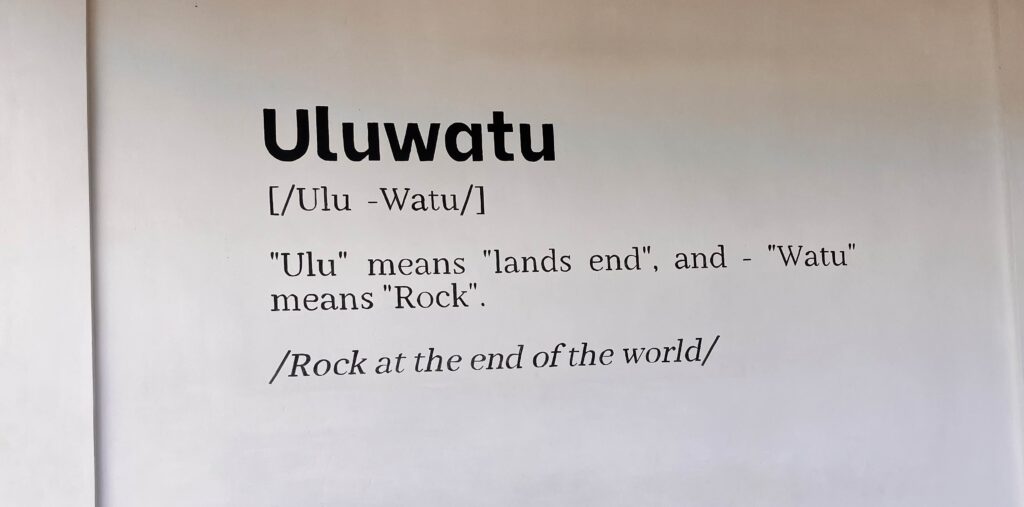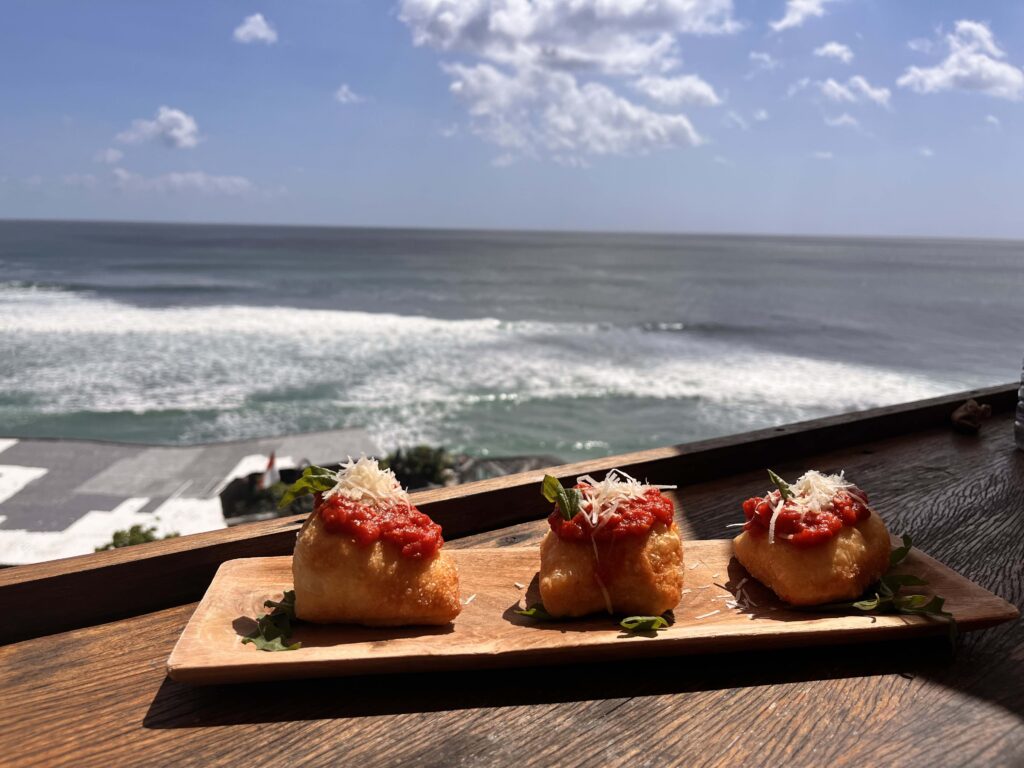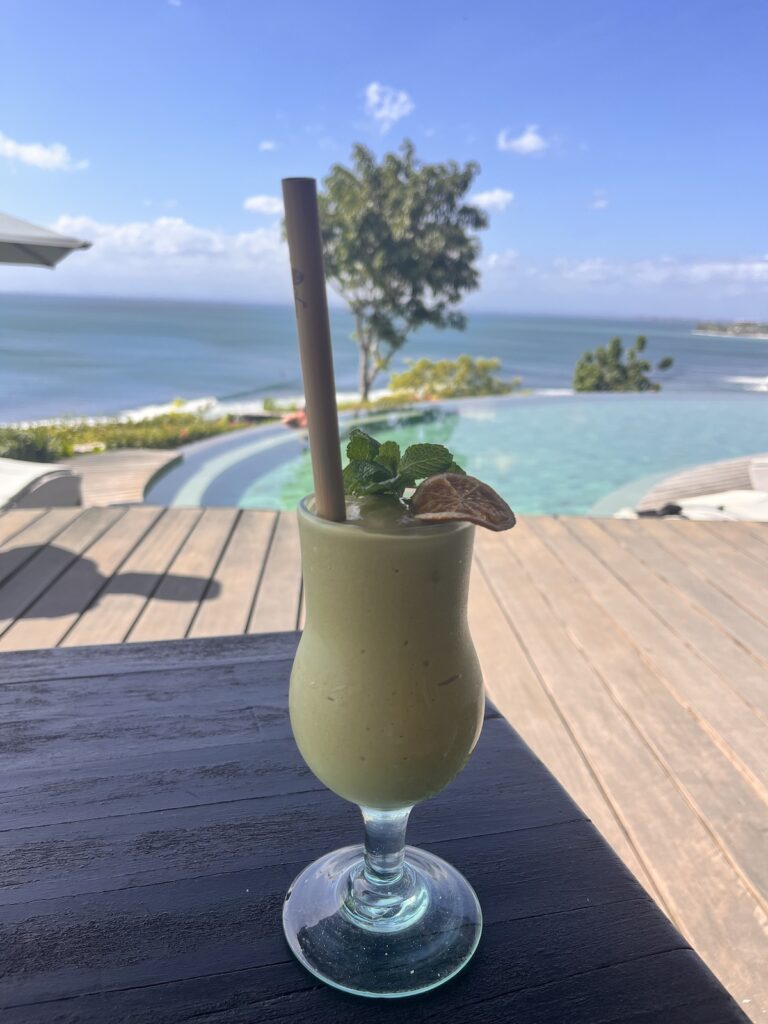Perched on the dramatic limestone cliffs of Bali’s Bukit Peninsula, Uluwatu has stolen my heart in ways that busier spots like Canggu or Seminyak never quite managed. Don’t get me wrong, those places have their charm and despite the crazy traffic of Canggu I do still like it, but there’s something about watching the sun sink into the Indian Ocean from a clifftop viewpoint in Uluwatu that hits different.
I’ve spent more time than I probably should admit bouncing between Uluwatu’s beaches, cafes, and hideaways over the years, and after a recent one month trip stay that started as a three-day trip somehow morphed into something more with this southern corner of Bali that keeps pulling me back.
If I’ve learnt anything from this, where you plant yourself in Uluwatu matters… A LOT!!!

Unlike the compact and relatively flat, walkable areas you might find elsewhere in Bali, Uluwatu sprawls across the peninsula with more peaks and troughs than the world’s wildest rollercoaster – each area being a little different to the next. You could be sipping a flat white at a hipster cafe near Padang Padang one morning, and watching traditional Kecak fire dancers at Uluwatu Temple the next evening, with a 15-minute scooter ride between them.
Whether you’re chasing perfect waves, planning a honeymoon splurge, travelling solo, or wrangling the kids (like I was on my last trip), I’ve learned that picking the right area and the right place to stay can make or break your Uluwatu experience.
So I’ve put together this guide based on countless conversations with friends who live in Uluwatu full time, other travellers I’ve met along the way and my own insights from a cumulative stay of around 3 months.
Ready to find your perfect Uluwatu stay? I’ve got you covered…
Our Favourite Places To Stay In Uluwatu
Anantara Uluwatu Bali Resort – is a luxury eco-retreat with stylish private villas, plunge pools, and lush gardens.
Gravity Eco Boutique Hotel – is an adults-only hideaway with tropical bungalows, pools, ocean views and thoughtful eco-conscious touches.
Three Monkeys Villas – A tranquil boutique retreat of private, air-conditioned bungalows clustered around a lush garden pool, just steps from Uluwatu’s surfing points and temples.
Why Uluwatu?
Uluwatu sits at the southernmost tip of Bali, perched atop the Bukit Peninsula like a crown jewel. This isn’t your typical Bali experience of rice terraces and monkey forests (though those are brilliant too). Instead, imagine dramatic 70-meter limestone cliffs plunging into turquoise waters, with the iconic 11th-century Uluwatu Temple standing guard over it all.
If you’re a surfer, you probably already know Uluwatu’s reputation. The breaks here include Padang Padang, Impossibles, Suluban (aka Uluwatu Beach) and they are the stuff of legend.
I’m a very beginner and very average surfer at best, and I’ve had some of my most humbling wipeouts here. But I’ve also caught the occasional wave that made me feel like a proper pro, if only for five glorious seconds.
That said, Uluwatu isn’t just for surf junkies. The beach clubs and infinity pools offer plenty for those who prefer admiring waves from a distance, cocktail in hand. And the Kecak fire dance performed nightly at Uluwatu Temple is something to behold.

But let’s be honest about a few things I wish someone had told me before my first trip. Uluwatu is not pedestrian-friendly. At all. The roads are narrow, winding, and often lacking footpaths. You’ll either need to rent a scooter (about £4-£8 per day) or budget for taxis. During my first visit, I naively booked a gorgeous villa that looked “close” to everything on the map. Turns out, it was close if you had wings. On foot? Not so much.
The beaches here require some effort too. Many involve descending (and later, climbing) steep staircases carved into the cliffs. I once counted 178 steps down to Bingin Beach. After a day of surfing and a couple of Bintangs, that climb back up was character-building to say the least.
Weather-wise, May through October brings dry, sunny days ideal for clifftop sunsets and beach hopping. November through April sees occasional rain, lower prices, and sometimes more trash washing up on the beaches due to changing currents.
I’ve visited during both seasons and found each has its charm, though I tend to prefer the shoulder seasons (April/May or October/November) when you get decent weather without peak crowds or prices.
Key Areas to Stay in Uluwatu
Uluwatu isn’t one place but rather a collection of little hubs, each with its own personality. Let me walk you through them.
Padang Padang (Labuan Sait)
Padang Padang feels like Uluwatu’s beating heart. It’s where most of the action happens. Jalan Labuan Sait, the main road running through this area, is lined with cafes, restaurants, and boutiques. It’s as close as Uluwatu gets to having a “town centre.”
The downside? It can feel a bit crowded, especially during high season. And those 100+ steps down to the beach are no joke in the midday heat (or after sunset for that matter).

My last visit here I stayed just off the main street in a really cool villa overlooking the Padang Padang valley – the serenity and view was unreal, although the walk back in the dark was less enjoyable.
Bingin Beach
If Padang Padang is Uluwatu’s high street, Bingin is its bohemian cousin. The vibe here is decidedly more laid-back, with a focus on surfing, sunset beers, and barefoot dinners at the warungs (local eateries) that line the beach.
I had one of my most memorable Bali evenings at Bingin, sitting on plastic chairs at a simple warung, eating grilled fish I’d selected myself from the day’s catch, with my toes in the sand. Later, we wandered over to Morabito for sundowners and impromptu live music.
The catch? Those stairs I mentioned—Bingin’s are particularly steep. And nightlife here is more “beers and stars” than proper bars or clubs. But if that sounds like your cup of tea (or coconut), you’ll love it.
Suluban Beach (Uluwatu Beach)
Suluban is where you’ll find the famous Uluwatu Temple and Single Fin, arguably the most iconic sunset spot in all of Bali. The clifftop views here are absolutely spectacular. I’m not typically one for crowds, but even I have to admit that the Sunday sessions at Single Fin, with DJs playing as the sun sets over the Indian Ocean, are pretty special.

The beach itself, also known as Blue Point, is accessed through a cave and is primarily a surf spot rather than a lounging beach. I made the mistake of bringing a non-surfing friend here once, promising a beach day. She was… unimpressed with the rocky shore and powerful waves.
The area has a lively, youthful energy but requires transport to reach other parts of Uluwatu. I usually stay here when I’m planning to surf Uluwatu’s breaks and want to be close to the temple for cultural days.
Balangan & Dreamland Beach
A bit further north, Balangan and Dreamland offer a quieter Uluwatu experience with more swimmable beaches. I stayed near Balangan on my most recent trip and loved the clean, wide stretch of sand—perfect for actual beach days, not just surfing.
Dreamland is a bit more developed, with a resort complex nearby, but still offers a beautiful beach with gentler waves in some areas. Both spots are closer to the airport (about 30 minutes), which I appreciated on my 6 AM departure day.
The trade-off? Fewer dining options and a need for transport to reach the main Uluwatu attractions. But if you’re after a more relaxed beach holiday with occasional forays into the busier areas, this could be your sweet spot.
Melasti & South Coast
The southern coastline, including Melasti Beach, represents Uluwatu’s more upscale, serene side. This is where you’ll find many of the luxury resorts with their infinity pools perched precariously over the cliffs.
Melasti Beach itself is one of the more accessible and swimmable beaches in the area—with actual sand rather than rock at low tide. I spent a day here during my last trip and was surprised by how calm the waters were compared to the surf beaches.
The southern coast feels more removed from the hustle of central Uluwatu, which is either a pro or con depending on what you’re after. When my parents visited, I booked them a villa near Pandawa Beach in this area, mainky because it’s far enough from the backpacker scene to ensure their peace and quiet, but still essentially Uluwatu with those dramatic ocean views.
Accommodation Recommendations by Budget
Let’s talk beds, breakfasts, and budgets, because where you decide to stay in Uluwatu can range from simple fan-cooled rooms to private pool villas that would make a celebrity jealous.
Budget (£20–£50/night)
I’ve had some of my most authentic Uluwatu experiences in budget accommodations. At Wira Homestay near Bingin, I paid about £25 a night for a clean, simple room with a lovely little garden. The family who runs it made me feel less like a guest and more like a family member visiting for the holidays. They even lent me their spare scooter one day when I struggled to book a Grab scooter taxi.
U Tube Hotel in Pecatu isn’t winning any design awards, but for around £20, it offers a solid, central base with decent WiFi and air conditioning that actually works (not always a given at this price point). I stayed here for three nights when I was travelling solo and spending most of my time out exploring.
Padang Sari Homestay near Padang Padang Beach is another gem I stumbled upon. For roughly £18, I got a clean room, a tasty breakfast, and a location that would cost quadruple in most other countries. The walls are a bit thin—I could practically join my neighbour’s phone conversations—but for the price and location, I couldn’t complain.
For those wanting to be near the quieter Melasti area, Waroeng Surya Home Stay offers budget-friendly rooms from about £20. The included breakfast was basic but tasty, and the family running it couldn’t have been more helpful with arranging transport and giving local tips.
Mid-Range (£50–£150/night)
Pink Coco Uluwatu is, as the name suggests, very pink. And very Instagram-friendly. I splurged on a stay here (about £120 per night) after a particularly good month of freelance work and enjoyed the adults-only policy and quirky design. The multiple pools mean you can usually find a quiet corner, and their breakfast smoothie bowls almost made me forget about the dent in my bank account.
BoHo Bingin has that perfect blend of style and substance. I stayed in one of their garden rooms (around £80) and spent most mornings at their infinity pool overlooking the ocean before heading down to Bingin Beach. The boho-chic design hits the sweet spot between luxury and laid-back.
Three Monkeys Villas near Suluban offers lovely bungalows with private terraces from about £70. Their breakfast (which is included in the rate) deserves special mention. The banana pancakes still appear in my dreams occasionally. The gardens create a tranquil atmosphere that’s a welcome retreat after a day of surfing or exploring.
Gravity Eco Boutique Hotel was a recent discovery near Padang Padang. Their commitment to sustainability isn’t just marketing—they actually walk the talk with plastic-free initiatives, water conservation, and locally sourced materials. Rooms start around £90, and the rooftop yoga deck offers sunset views that made me briefly consider becoming a morning person. Briefly.
Luxury (£150–£400+/night)
Look, I can’t pretend I regularly drop £200-£300 a night on accommodation, but I have had a couple of special splurges that were worth every penny.
If you are looking for a family stay and want to be near to the action then this villa near Padang Padang beach was perfect when we stayed there for a week during August 2025. It has jungle-like valley views and feels completely remote, but is just a 3 minute walk to Padang Padang beach (and all the restaurants and cafes nearby).
The infinity pool is simply divine and I loved the industrial chic design of the villa, blending exposed brickwork, polished concrete and wood elements to perfection.

Anantara Uluwatu Bali Resort is cliff-edge luxury at its finest. My partner and I stayed here for two nights to celebrate our anniversary (starting at about £250 per night), and the panoramic ocean views from our room were simply spectacular. The infinity pool seems to blend right into the horizon. One slightly awkward note—the pool is visible from some public areas, so those Instagram shots of me pretending to be a mermaid were apparently quite entertaining for other guests.

The Istana focuses on wellness and serenity, with spa treatments and yoga classes that helped me recover from a particularly ambitious surf session. Rooms start around £220, but the sense of peace and the clifftop setting make it feel justified. Their outdoor dining area provided one of the most romantic dinners I’ve had in Bali.
Umana Bali opened fairly recently near Melasti Beach, and I haven’t stayed there personally, but friends who splurged on a stay (around £350 per night) couldn’t stop raving about the private infinity pools and the exclusive atmosphere. It’s definitely on my “one day when I win the lottery” list.
And then there’s Alila Villas Uluwatu which is the pinnacle of Uluwatu luxury. With villas starting at £600 and soaring upwards, it’s a serious splurge. I was lucky enough to attend a wedding here once and got a peek at the accommodations. The 3,000-square-foot villas with their private pools and cabanas are essentially what I picture when someone says “dream home.” Yes, it’s isolated from the main Uluwatu attractions, but at that level of luxury, you might not want to leave anyway.
Our Favourite Places To Stay In Uluwatu
Anantara Uluwatu Bali Resort – is a luxury eco-retreat with stylish private villas, plunge pools, and lush gardens.
Gravity Eco Boutique Hotel – is an adults-only hideaway with tropical bungalows, pools, ocean views and thoughtful eco-conscious touches.
Three Monkeys Villas – A tranquil boutique retreat of private, air-conditioned bungalows clustered around a lush garden pool, just steps from Uluwatu’s surfing points and temples.
Practical Tips for Choosing Your Stay
After several trips to Uluwatu I’ve picked up a few practical insights that might save you some headaches.
First, transportation is non-negotiable here.
The sprawling layout means you’ll need either a scooter (£4-£8 per day) or budget for taxis (£3-£10 per ride). I learned to ride a scooter specifically for Bali, and while those first few days were terrifying, it’s now my preferred way to explore. If you’re not comfortable on two wheels, apps like Grab and Gojek work in most areas, though I’ve encountered the occasional “taxi mafia” zone where only local drivers are permitted. In those cases, your accommodation can usually arrange transport.
Beach expectations are important too. If you’re picturing gentle waves and all-day swimming, you might be disappointed by beaches like Padang Padang or Suluban, which are primarily surf spots with strong currents.
For more swimmable options, head to Balangan, Dreamland, or Melasti. And yes, during rainy season, some beaches do collect trash that washes in with the currents. I once arrived at Bingin after a storm to find plastic debris scattered across the sand, by the next day, though, locals had cleaned most of it up.
For dining and nightlife, each area has its highlights. Single Fin in Suluban is the undisputed king of sunset sessions, especially on Sundays. El Kabron in Pecatu offers a more sophisticated clifftop experience with Spanish cuisine and DJ’s playing out.
Bingin’s beach warungs serve fresh-caught seafood at plastic tables on the sand which is simple but unforgettable. For brunch, Drifter Cafe and The Loft near Padang Padang are local institutions.
Cultural experiences shouldn’t be missed, even if beaches are your primary focus. The Kecak fire dance at Uluwatu Temple is spectacular, but arrive at least 90 minutes before sunset to secure tickets and good seats.
Final Thoughts: Finding Your Perfect Uluwatu Stay
Uluwatu is one of those places you will most likely want to come back to again and again – that’s if you actually leave. It has a dramatic coastline and some seriously happening places to visit. The vibe is a lot younger than places like Kuta, Legian and even Seminyak, but it’s loved by all.
My last piece of advice? Book early, especially for high season, when the secret of Uluwatu’s magic is very much out. And don’t overplan… leave room for spontaneous sunset sessions, unexpected beach discoveries, and those perfect moments when you find yourself thinking, “I could stay here forever.”
Because trust me, that thought will cross your mind at least once during your Uluwatu stay. It certainly crosses mine every time I visit.
